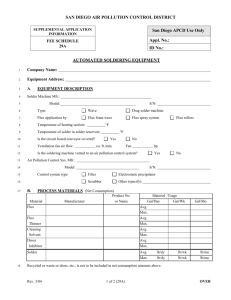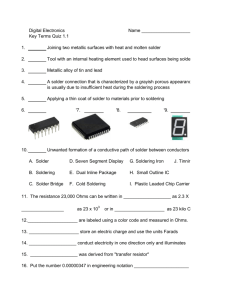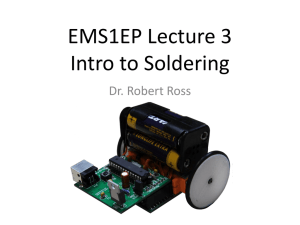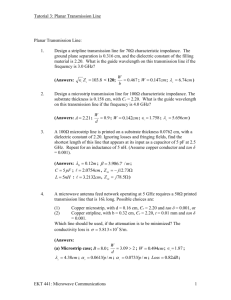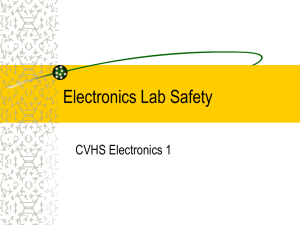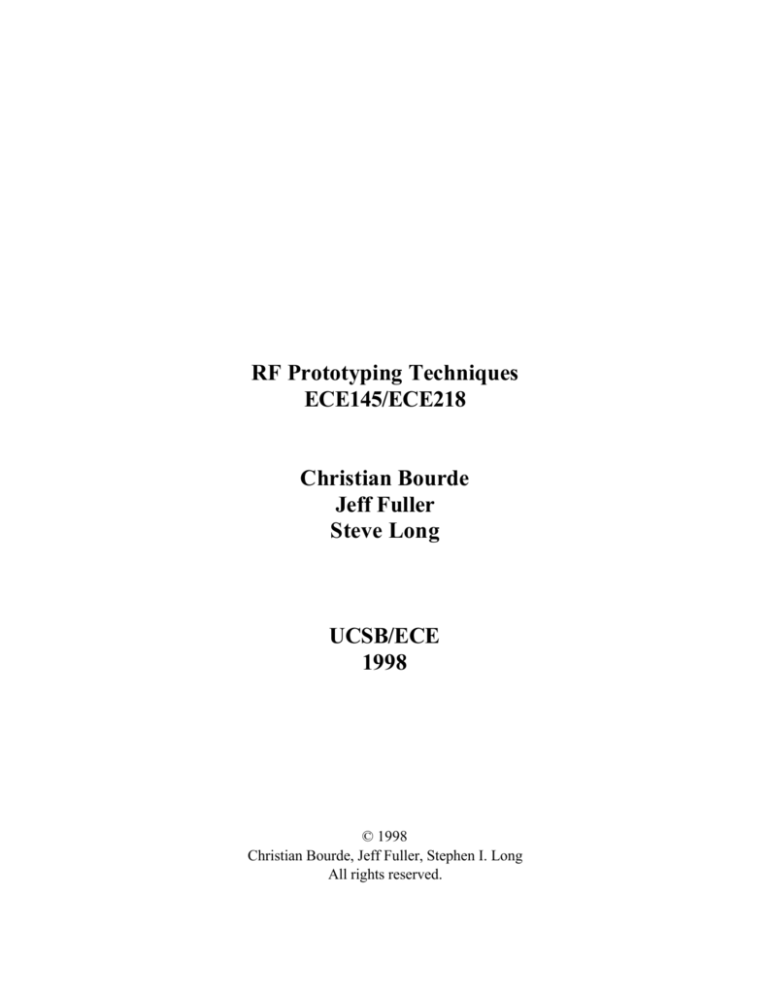
RF Prototyping Techniques
ECE145/ECE218
Christian Bourde
Jeff Fuller
Steve Long
UCSB/ECE
1998
© 1998
Christian Bourde, Jeff Fuller, Stephen I. Long
All rights reserved.
Laying the Foundation
Ground Planes and Circuit Board Materials
Ground Plane
A ground plane is a continuous conducting sheet, usually copper, which forms the
bottom layer of a RF circuit board’s foundation. If you envision signals traveling in
An RF board as propagating waves, it’s easy to understand the need for a ground plane.
It forms the continuous common reference for propagation and impedance throughout
the board.
Those with experience prototyping audio and low speed digital circuits are no doubt
familiar with the standard jumper boards with binding posts for power connections.
Don’t use these for RF ! Although they contain ground pins or traces, they lack the
continuous conducting ground plane sheet which is essential at radio frequencies. And,
their multi pin structure contains a host of unwanted stray reactances which can spell
disaster at frequencies above a few MHz.
Substrate
The substrate forms the middle layer in the foundation. It can be made from a variety
of dielectric materials, depending on the board’s intended frequency range and application.
At the low end of the frequency and price range are fiberboard (G10) and fiber
epoxy series (FR4) commercial board materials generally usable up to about 1 GHz,
above which dielectric losses increase rapidly. Duroid and other trade name microwave
board materials are usable at higher frequencies (and prices).
Conductor
The top layer of the board contains the copper traces that connect circuit elements.
Layout and interconnection of these traces is critical at radio frequencies since every
trace is a transmission line and every pad contains some inductance or capacitance whether intended or otherwise. The importance of proper board layout is one of the
key differences between low frequency and RF prototyping.
Fig. 1. This type of plug board is suitable for prototyping bias networks and audio
amplifiers. Don’t try to use it for RF.
Signal Routing
Transmission Lines and Connectors
Rule Number 1 - Keep it short !
Those long looping pieces of insulated hookup wire common to low frequency
prototyping aren’t a good idea at radio frequencies. Their impedance is random
as they move and couple to nearby objects and they often behave more like antennas
then signal pipes. A general rule of thumb for RF connections - shorter is better.
At UHF frequencies and above, if you can see the leads, they’re too long.
Transmission lines are needed to provide controlled pathways for RF signals microstrip within the board and coaxial cable to connect different boards.
Within the Board
RF signal traces within the board are made from a type of transmission line known as
microstrip - flat copper strips connecting various signal destinations. Microstrip
impedance is a function of line width and other factors. In general, wide lines have low
characteristic impedance with the value rising as the width narrows.
Line impedance within the board is generally less important at lower frequencies (HF)
but becomes more critical at UHF frequencies and above. At microwave frequencies,
sections of microstrip are used to synthesize capacitors and inductors for resonating and
impedance matching, making both length and shape of each trace critical.
A good rule of thumb for routing signals in fiber epoxy board is the 1/8 inch line width
(0.105 - 0.125 inch depending on board dielectric) which represents a Z0 of about 50
ohms. Tables and software are available for calculating exact width for a desired
impedance in the high end board materials ( reference (1) ).
Microstrip lines can be produced either by etching one side of a double sided circuit
board ( copper is left on the other side to form the ground plane ), or by cutting and
pasting adhesive backed copper foil tape on top of a single sided circuit board. Figures
2 and 5 show examples of microstrip layout. One important point - RF doesn’t like
sharp corners. When making a 90 degree turn in microstrip, bevel the outside edges at
45 degrees as shown below.
Microstrip bend.
Entering and Leaving the Board - Launcher Blocks
Signals entering and leaving the board generally do so via coax to microstrip transitions.
In prototyping work, a fixture known as a “launcher block” is often used for
this purpose. One can envision the incoming signal leaving the tip of the coax connector
and being “launched” as a wave into the microstrip. Shown in figure 2, this fixture
consists of a drilled and tapped rectangular aluminum block designed to be attached to
the ground plane side with machine screws and mounted flush with one end. A coaxial
connector is attached to the block such that its center pin just rests on the microstrip.
It’s important for the connector block, connector, and board to fit together snugly and
squarely in order to minimize signal loss during the transition.
Connectors
BNC and SMA connectors, shown in figure 3, are probably the most popular for
low power RF assemblies. BNC connectors are suitable for frequencies up to 1-2 GHz,
while SMA connectors are useful well into the microwave range. Ideally, a coax
connector and launcher block should be used for each RF signal which enters and leaves
the board. For short cable runs and module interconnections and frequencies below about
100 MHz, carefully soldering the coax directly to the board can be a practical alternative.
Coax Cable
During initial development, it’s a good idea break up circuits into functional modules
with each module on a separate circuit. When routing signals to and from test equipment
or other modules, it’s important to use high quality coaxial cable. Use the type designed
for RF (not audio). It should have a continuous braided shield and, ideally, a loss of
less than 3 dB per 100 ft at the frequency of interest. Cable designations and loss factors
are tabulated in a number of handbooks. Values for some of the more common cables are
listed in Table I. 50 ohms is normally chosen as the standard cable impedance, although
other impedances are used in specialized applications, such as cable television.
SMA
connector
Launcher blocks
Fig. 2a The top side of an RF board employs sections of microstrip transmission line to
connect the components.
Fig. 2b. A continuous copper ground plane covers the reverse side. Small holes can be
drilled to allow components such as the transistor and bias resistors shown here access to
the circuit side.
Table I
Coaxial Cable Characteristics
Cable
Z0
(nom)
Atten per 100 ft (dB) at FMHZ =
10
100
200
500
1000
outside dia
(inches)
RG-174
50
3.8
>10
0.100
RG-58
53.5
1.3
4.8
7
>10
RG-59
73
1.3
3.8
5.5
8.5
>10
0.242
RG-8
52
0.7
2.5
3.8
6.5
9.5
0.405
RG-11
75
0.7
2.5
3.8
6.5
9.5
0.405
Belden 9913 50
0.42
1.4
2.0
3.2
4.5
0.405
7/8 inch
hardline
0.12
0.45
0.8
1.5
2.3
0.875
50
0.195
Controlling Undesired Signal Paths
RF Chokes - Blocking the Path
A radio frequency choke (RFC) is a circuit element designed to present a high
impedance to radio frequency energy while offering minimal resistance to direct
current. RFCs are frequently used in series with power supply leads both to keep
RF from coupling via undesired power supply paths and to prevent power supply
components from paralleling undesired impedances across the RF circuit.
When selecting an RF choke, the first inclination might be to pick one with the
highest inductance available. This is often a poor strategy, since the nonideal
behavior of RFCs means that they will have both shunt and series capacitances,
causing self resonances at a variety of frequencies. This self resonant behavior can
actually cause an RFC to behave like a coupling capacitor at some frequencies ! It’s
better to select a choke which presents an impedance several times that of the RF
circuit at the point of connection and presents broadband high impedance behavior
in the frequency band of interest. When in doubt, check it out on the network analyzer.
Some general guidelines:
Table II
Radio Frequency Chokes
Frequency band
Suitable Chokes
MF (455KHZ IF)
10’s of mH
molded choke
HF
100’s of µH
molded choke
VHF
ones - tens of µH
molded chokes, ferrite beads
UHF
hundreds of nH
low Q air core inductors
ferrite beads
microwaves
quarter wave line / low pass filter
combinations
Fig. 3a. A variety of toroidal cores (right) are available for winding inductors at
frequencies from a few MHz to about 200 MHz. Air core inductors (left) can be used at
VHF and UHF frequencies. There are also chip inductors that are available in small
values of inductance.
Fig. 3b. RF chokes (RFCs) can employ ferrite beads (left) or molded inductors (right).
Broadening the Isolation
Having selected an RF choke which presents a high impedance at the design frequency
with no nearby self resonances, the next task is to minimize the effect of any out of band
self resonances. This is important, since RFC self resonances can encourage parasitic
oscillations.
Their ability to offer relatively high impedance over a broad frequency range makes
ferrites useful for this purpose. Broad band radio frequency chokes may be constructed
by placing a ferrite bead over one lead of a molded choke as shown in (a) below. RFCs
for VHF/UHF frequencies can be constructed by placing a ferrite bead over one end of an
air wound choke, or by winding several turns through a multi hole ferrite bead. Another
technique applicable to low current circuits involves adding a small value resistor ( 10 100 ohms ) in series with the choke. as shown in (c) below. A ferrite bead over the end of
the resistor lead can also help this process.1
ferrite
bead
RFC
a. Adding a small
ferrite bead over one
lead of a molded choke
can reduce resonance
effects.
b. A VHF/UHF choke
made from a multi hole
ferrite bead.
c. A low value resistor and ferrites can be
combined to make a
broad band choke for
a low current circuit.
Bypass Capacitors
Shunt capacitors are used to provide to provide low impedance paths to ground at RF.
As in choosing chokes, the largest value available isn’t necessarily the best choice.
Capacitors, like inductors, display nonideal component behavior which may cause them
to have self resonant frequencies. As a result, they may appear inductive above certain
frequencies, presenting a high impedance path to ground instead of the intended bypass.
Again, it’s wise to check out unknown components on the network analyzer, particularly
if they are intended for application at VHF or above.
Bypass capacitors across power supply lines serve two functions - preventing RF
from coupling through the power supply, and preventing noise components riding on
1
Refer to the supplement “Inductor Construction” for information on ferrite selection for RFCs.
the power supply voltage from coupling into sensitive RF circuits. Therefore, its a
good idea to parallel one or more bypass capacitors - one to provide a low impedance
at RF, and a larger one to provide low impedance at lower frequencies.
Some general guidelines for choosing capacitors:
Table III
Radio Frequency Capacitors
Frequency band
Suitable Capacitors for bypass or DC block
MF (455KHZ IF)
0.1 µF
ceramic disk
HF
0.01 µF
ceramic disk
VHF
100’s of pF
molded mica,
ceramic chip
UHF
hundreds of pF
ceramic chip
microwaves
10’s - 100’s of pF
ceramic chip
quarter wave line combinations
Fig. 4a. Fixed capacitors for radio frequencies. The monolithic cap(top) is suitable for
use up to about 250 MHz, depending on its value. Chip caps (bottom) should be used at
frequencies above 250 MHz.
Fig. 4b. Variable capacitors. The ceramic trimmer (left) is useful to about 200 MHz,
while versions of the piston cap (right) are available for use above 1 GHz.
Decoupling
In low current circuits, adding a small series resistor can aid in isolating stages from
each other and from power supply noise. The combination of decoupling resistor and
capacitor forms a low pass filter.
+ VCC
47
.01
1K
Fig. 5. This common emitter amplifier uses decoupling for added isolation.
+ VCC
.01
.1
RFC
47
.01
matching
network
Fig. 6. This two stage RF power amplifier illustrates use of decoupling, RF choke, and
bypassing.
+ Vcc
R
R
FB
FB
FB
FB
R
FB = ferrite bead
R = small decoupling resistor
R
- VEE
Fig. 7. In circuits with two power supplies, it’s important to add proper decoupling to
each supply. The schematic above shows ferrite beads and decoupling resistors
added in series with each supply connection.
Resistors
Resistors exhibit varying degrees of nonideal component behavior, depending on
their construction. At radio frequencies, a resistor might be modeled by:
(a) Wirewound resistors. Their high self inductance makes them unusable for RF.
(b) Carbon composition. Parasitic capacitance between carbon granules makes C
large. Suitable for use at lower radio frequencies.
(c) Metal film. The best choice for use at radio frequencies below about 500 MHz.
(d) Chip resistors. Consider using these above 500 MHz, especially for higher
resistance values. They are usually required for resistors in the RF portion of circuits
above 1 GHz.
Single Point Grounding
When grounding key circuit points, such as emitter bypass capacitors, try to connect
their physical grounding points as closely together as possible. Even a small run on the
PCB can create ground loops with undesired resonances.
Make these connections as
close together as possible.
Fig. 8. The 3 ground points should be physically close together on the board.
Construction
Modules
When building the initial prototype, it can be helpful to break up the circuit into
functional modules and test each one individually. For example, a VHF frequency
synthesizer might be broken into three modules - (1) a VCO, (2) a buffer amplifier and
prescaler, and, (3) divider and synthesizer control logic. After confirming proper circuit
operation for each board, the modules could be integrated using # 4 stacking spacers and
short lengths of coax. Here is an example of two interconnected units on spacers mounted
to a larger sheet of PC board. Twisted pairs of wires are used for interconnects.
Fig. 9. Image reject mixer layout from ECE218B. At left is the IF summing board. At
right is the mixer and phase shifter board.
When the prototype is completed, performance will improve if mounted in an aluminum
box. The interference between your project and coupled signals and noise from other
projects, generators, and radio stations can cause serious measurement difficulties.
Fig. 10a. 10.7 MHz IF amplifier/FSK decoder prototype using vectorboard with
metalized islands in aluminum project box.
Fig. 10b. Front panel of IF amplifier/decoder box.
Board Layout
In general, component layout should follow a direct path from input to output. It’s
important to keep the two apart, especially in high gain circuits. Other general guidelines
include:
- Keep paths short and direct - especially ground connections
- Keep power and RF paths apart to avoid unwanted coupling.
- Consider including test points to permit monitoring signals at key nodes.
- Consider using topside grounds to provide additional isolation between high gain
inputs / outputs. (Topside grounds are connected to the ground plane by periodic via
holes soldered on both sides.)
Figure 11 illustrates some these techniques applied to the translation of an RF
circuit from schematic to PC board.
U310
in
out
C2
C1
L1
Rs
L2
Cbypass
Rd
Vdd
Fig 11a. Schematic of a low noise amplifier.
Cbypass
Fig. 11b. Layout of 440 MHz LNA from ECE218A.
Fig. 11c. Layout of 145 MHz LNA from ECE145A.
input
Board Construction
Adhesive backed copper tape can be used for prototyping simple circuits as shown in
Figs 11b and c and is particularly effective for microwave layouts on single sided Duroid
type board. The tape can be cut to the proper size and shape with a razor knife and then
applied to the board.
Ground-Plane Board Construction
An alternative construction method called ground-plane construction (aka. Ugly or dead
bug construction) can also be used with good results for RF circuits. Rumor has it that it
works better than PC board layout for RF applications where low inductance ground
returns are essential. It uses the unetched surface of a PC board as the ground return and
physical support for all components. Any component that returns to ground such as
bypass capacitors or biasing resistors are soldered directly to the copper. Ungrounded
connections between components are made point-to-point. The leads are kept as short as
possible. This technique can even be used with chip capacitors and resistors by standing
them up on end. Connections on and off the board are made by soldering coax cables
between the ground plane(shield) and the input/output nodes.
Be sure that the board and component leads are clean and shiny before soldering. Use
extra-fine steel wool or a scouring pad to polish prior to soldering. For more information
on this approach, see Ref. 6.
The figure below illustrates a good example of this technique.
Figure 12. Coupled resonator bandpass filter using ground plane construction [7].
Etched boards.
More complex circuits, particularly those containing integrated circuits, may require
an etched board. Making such a board is basically a three step process:
(1) Design a board layout on paper using a CAD program or templates.
(2) Apply the layout pattern to the board using etch resistant material.
(3) Place the board in a chemical etching bath until the unwanted copper
has been removed.
There are many ways to etch boards. Three of the most successful are described here.
The methods vary in ease and complexity. An outline on the next page details the pros
and cons of each method. The following paragraphs are intended to provide a bare bones
description of what materials are required, where they can be acquired and the steps
necessary to generate etched PC boards. Etched PC boards offer a convenient,
professional way to construct your circuits and offer the potential to reduce RF problems
frequently encountered using other construction techniques.
All etched PC boards begin with an insulated substrate (duroid and fiberglass for
example) and are covered by a solid layer of copper on one or both sides. The idea
behind etching is to place a protective covering (ink, tape, toner, photoresist) on the
copper with the desired pattern. Once the pattern is laid out the board is placed in a ferric
chloride etchant which “eats” away the exposed copper. When the etching process is
finished, the protective layering is removed, the board is washed, dried, and ready to be
drilled. What remains is to solder the components on the board similar to kit building.
The easiest, quickest and cheapest way to generate etched PC boards is to use rub-on
pads and traces. (Fig. 13) Pads are where the component legs are soldered; traces are the
lines which interconnect the pads. Decals are transferred by rubbing onto a clean copper
surface with a blunt pencil. Clean the copper with alcohol to remove grease before
transferring the decal. Once all the pads and traces have been laid out, check the board to
make sure that all the rub-ons are securely attached to the board and that the circuit is
correct. Now the board is ready for etching. The only drawback of this method is that it
is sometimes difficult to get the rub-ons to stick. This can be due to a number of reasons:
dirty board, bad batch of rub-ons, humidity and temperature of the PCB to name a few.
On the other hand, mistakes are easy to fix: just scratch off the rub-on.
The next two methods differ in that they require additional steps to generate the layout
pattern. Layouts can be generated using any CAD/drawing program you are familiar
with. Check the appendix for locations on where to obtain evaluation CAD/drawing
packages.
Once the layout pattern is generated using the computer, two different methods are
available for placing the pattern onto the PCB. The first method involves putting the
pattern on film using either a laser printer or photocopier. It is important that the pattern
is printed using toner – ink-jet printers will not work. Once the toner is on the film, the
pattern is applied to the clean copper surface using an iron at a low heat setting. The idea
is to transfer the toner from the film to the copper board. Suitable film is readily
available locally or through mail order (check the appendix). Note that the layout can
also be transferred from a paper copy to the film using a photocopier. Just be careful to
avoid reduction in size due to the copier; holes may not align properly.
Fig. 13. A variety of techniques are available for prototyping RF boards. PressNPeel
(top) can be used to transfer laser printed resist patterns to the board using a steam iron.
Rub-on decals (center) can be applied directly to the board. Adhesive backed copper tape
(bottom) can be used to create microstrip patterns.
The third method is the most involved, expensive, and difficult. The basic process
involves transferring the layout pattern onto any kind of transparent film using either
laser or ink-jet printers. Next, the PCB must have a special photoresistive coating. These
boards can be bought locally or via mail order at moderate cost ($8 – 15), or the boards
can be coated using a suitable etch resist sensitizer. The photosensitive boards must be
handled in subdued lighting, must be exposed to a strong source of UV light (sunlight is
great) and finally must be developed to remove the exposed photoresist. At this point the
board is etched in the same way as the other methods described above.
There are a few factors to consider when developing these boards. First, the thickness of
the transparent film can affect line widths. This can be corrected by making sure the
artwork side of the transparency is in direct contact with the board surface. Second, the
printed patterns must be very dark. Exposure time can be adjusted to account for
nonideal opacity.
Etching
Once the PC boards have the artwork applied, the boards are immersed in a warm
solution of ferric chloride which should cover the board by about 1/4”. The etchant is
easily available at local stores or via mail order. The etching should be done in a plastic
or glass container; ferric chloride etches metals very rapidly! Be sure to have good
ventilation. The boards can take anywhere from 15 to 45 minutes to develop depending
on the temperature of the bath, the agitation, and how fresh the solution is. Once all the
exposed copper has been etched away, wash the board thoroughly under running water.
This will stop the reaction from possibly etching away your traces. Don’t worry if some
of the traces were accidentally removed – this is easily fixed. The next step is to drill the
board. This should be done using either a drill press or a high-speed drill with size 63-69
drill bits. Do not remove the protective layer on the copper traces; remove this only
when you are ready to solder components. This will help prevent oxidation.
Soldering
Soldering is the connecting of a two or more conductors together by melting solder, a
metal which melts at a low temperature (well, 600 degrees Fahrenheit is low for a
metal!), until it flows and forms a mechanical and electrical connection between those
conductors. There are two basic soldering methods you are likely to come across. One
uses rosin core solder, which is the most common solder around and is good for most
applications. This solder contains a resin which helps the solder initially stick to the
metal and is usually burnt off rather quickly during the soldering process. Note, this resin
is sometimes the cause of cold solder joints. A cold solder joint will have a dull
appearance, will yield poor electrical connections and can cause erratic circuit
performance. Cold solder joints can also be identified by ball-like lumps instead of a
smooth flow between metal and solder. Eliminate cold solder joints by momentarily
applying the soldering iron to burn off the excess resin. As a side note, you should
always use rosin core solder with electronic equipment. The acid in the acid core solder
you can get at a hardware store will eat through the conductors in your circuit.
The second soldering method uses a separate liquid flux and non-rosin core
solder. This method is especially well suited for surface mount applications. The liquid
flux is applied to regions where solder is desired. The soldering iron and solder are then
brought simultaneously to the soldering point which contains the flux, the flux functions
in the same manner as the resin in the rosin core solder. The previous method is
preferred for most applications, however mounting surface mount components can be
facilitated using the second method.
Successful soldering is easy to achieve if you remember a few simple rules. The
connection to be soldered must be clean. Copper oxidizes and forms a non-conductive
layer if left exposed to air. This causes cold solder joints in addition to making it difficult
to apply solder. Ajax and a scrub sponge can be used to obtain a clean surface. Alternatively, you can used steel wool, a small file, sanding pen or steel brush depending on
what needs to be cleaned - be mindful that you do not remove the copper you are trying
to clean!
When first using a new soldering gun or iron, coat the tip with solder to prevent
oxides from forming. Immediately brush off the excess solder with a soft cloth or damp
sponge so that the tip of the tool has a smooth, silvery appearance. This process is called
'tinning', and should be done whenever the soldering tip loses its shine. Do not let the tip
buildup excessive junk - this can corrode the tip and cause cold solder joints.
Apply the tapered surface of the tip to the connection. Allow the connection to
become hot, then apply the solder. Do not let the components become excessively hot this can change their values or worse destroy the component you are trying to solder! Do
not use the tip of the soldering iron or gun to melt the solder; let the connection melt it to
avoid cold solder joints. When the solder begins to flow, carefully lift the tip and solder
away from the connection, being careful not to move the parts being soldered. That’s it.
All that remains is to use the diagonal cutters to cut the excess leads.
Appendix I
Microstrip Techniques
At frequencies above about 0.5 GHz, sections of microstrip transmission line can be
used to synthesize inductors and capacitors. In general, open circuited stubs less than 1/4
wavelength long behave as capacitors and shorted or series sections less than 1/4 wavelength long are inductors. The lumped element transmission model below helps explain
why its a good idea to use high impedance line ( 80 - 90 ohms ) for inductors and low
impedance line ( 20 - 30 ohms ) when making capacitors.
...
...
Given the equation for characteristic impedance of the line, it can be seen that high im
pedance lines contain high L and low C - the desired quality for an inductor. Similarly,
the model for low impedance line has high values of C and low L.
The LINECALC module in EESOF is useful for this type of design. A simple DOS
program is also available for designing microstrip lines on Duroid. Called MWI, it’s
available from the Rogers Technology web page ( http://www.rogers_corp.com ).
Example: A 5 nH microstrip inductor at 2.5 GHz on RT5870 Duroid ( the material
used in the 2” x 3” prototyping boards in the lab ).
(a) Using MWI, an 82.1 ohm line is found to be 2 mm wide on RT5870 Duroid.
This value is chosen for ease of fabrication.
(b) At 2.5 GHz, 5 nH has a reactance of +j78.5. Normalized to the 82.1 ohm line
impedance, XL = +j0.957. This value can be realized by moving 0.122 wavelengths
toward generator from the short circuit point on the Smith Chart. Therefore, the
desired inductor can be made from 0.122 wavelengths of 82.1 ohm microstrip.
(c) Again using MWI, 82.1 ohm line is found to have a wavelength of 87.6 mm in
RT5870 at 2.5 GHz. 87.6 x 0.122 = 10.7 mm.
(d) The inductor then consists of a section of microstrip 2 mm wide and 10.7 mm long.
Appendix II
RF Transformers
Toroidal cores are ideal for prototyping RF inductors and transformers at frequencies
from a few hundred kHz to a couple hundred MHz. They provide a high degree of
self shielding and a predictable Q. Reference (3), available from the manufacturer for
the asking, provides an excellent overview of RF toroids and winding information for
a variety of cores.
The subject of RF transformers is a specialized area worthy of a separate book.
Reference (5) is an excellent guide to this subject. A few brief guidelines:
(1) The first inclination when winding an RF transformer may be to make sure
that the primary and secondary self impedances are many times those which will
be connected to the transformer. This isn’t necessarily the best choice, especially
at higher RF frequencies. It often results in a large number of turns on a small core.
When this happens, the turns are too close to each other and interwinding capacitance
effectively shorts them out.
(2) A higher permeability core, particularly a ferrite, with fewer turns will provide
better transformer action. Reference (3) and the Inductor Fabrication guidelines
provide guidelines for selecting appropriate core materials for the design frequency
range. Use the vector network analyzer and adjust the turns ratio and configuration for
the desired response.
(3) Transmission line transformers are often more effective at higher frequencies.
They are described in detail in references (4) and (5).
Appendix III - Sources
ECE Shop – 5th floor Eng I. PC boards, copper tape, rub-ons, etchant, components,
hardware, cases – also a good source of information in general.
Radio Shack. 179 N. Fairview, Goleta. 964-2500 – Etchant, rub-ons, copper boards,
cases.
Marvac Electronics – 5184 Hollister Ave, Santa Barbara – 681-2524 – PC boards,
photosensitive chemicals + boards, rub-ons, etchant, components, misc. hardware, cases.
Specialty Tool and Bolt – 108 Aero Camino, Goleta – 968-3581 – They have the small
drill bits, sizes 63-69.
http://www.microsim.com/ They have evaluation software which could be used to
generate layout artwork – part of their PSPICE package. Check site for free CD of their
evaluation products.
http://www.tommysoftware.com/ - Layout software. Somewhat unorthodox drawing
methods compared to AutoCAD. Check for free demo version. Steep learning curve.
http://www.Ivex.com/ - They have free dome software specifically designed for
generating layout artwork, extensive component libraries. Medium learning curve.
http://www.protel.com/ - CAD package for generating layout artwork and more.
http://www.orcad.com/ - CAD package for generating layout artwork and more.
http://www.technowin.com/ - CAD package
http://xenoy.mae.cornell.edu/cad-info.html – list of other CAD/CAM software suppliers
http://www.digikey.com/ - Components, hardware, and more – can request free catalog
http://www.jameco.com/- Components, hardware, and more – can request free catalog
http://www.mouser.com/index.html – components, hardware, and more – can request free
catalog.
http://www.allcorp.com/ - Components, hardware, film, and more. Hard to find RF
components.
Appendix IV
References
(1) The ARRL UHF/Microwave Experimenter’s Manual
American Radio Relay League, 1990
(2) The ARRL Handbook for Radio Amateurs
American Radio Relay League, 1997
(3) Amidon Associates: Iron-Powder and Ferrite Coil Forms
Catalog available from Amidon Associates, PO Box 25867
Santa Ana, CA 92799. Also see “Inductor Fabrication Guidelines”,
UCSB/ECE, 1998.
(4) Bowick, Chris. RF Circuit Design
Howard W. Sams & Co., Inc. 1982
(5) Sevick, Jerry. Transmission Line Transformers
American Radio Relay League, 1990
(6) Hale, B. S., “Build It Yourself from QST, Part 2, “ pp. 35-39, QST, May 1992.
(7) Lau, Z., QEX, Sept/Oct 1998.



